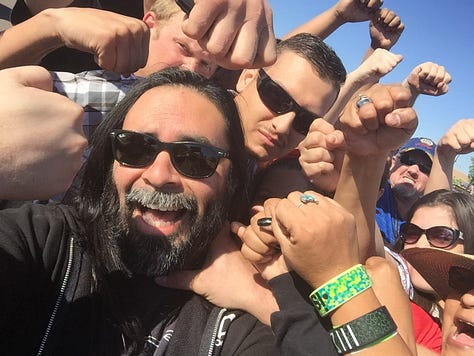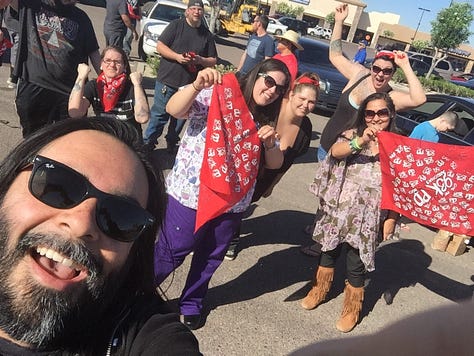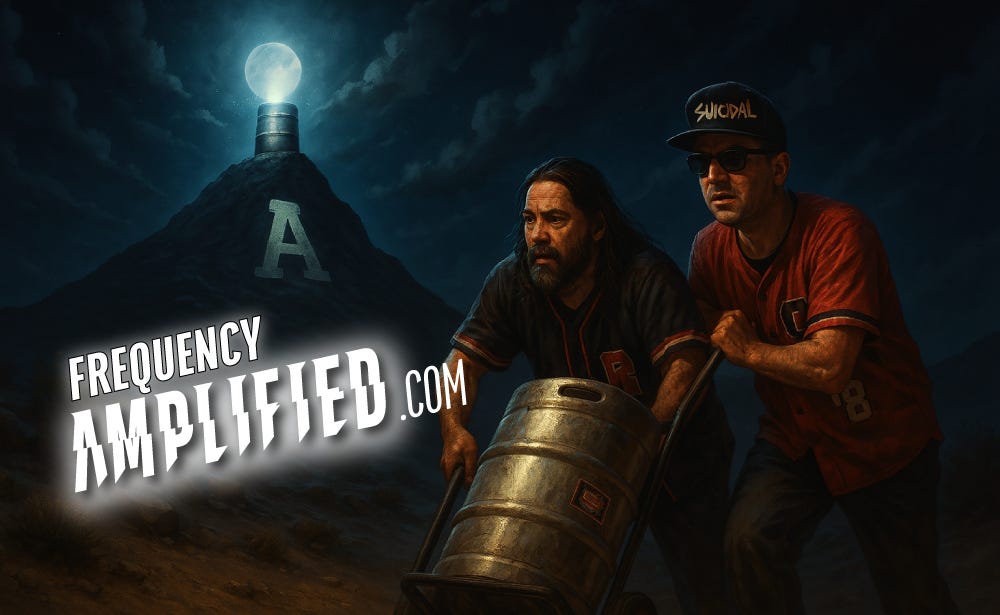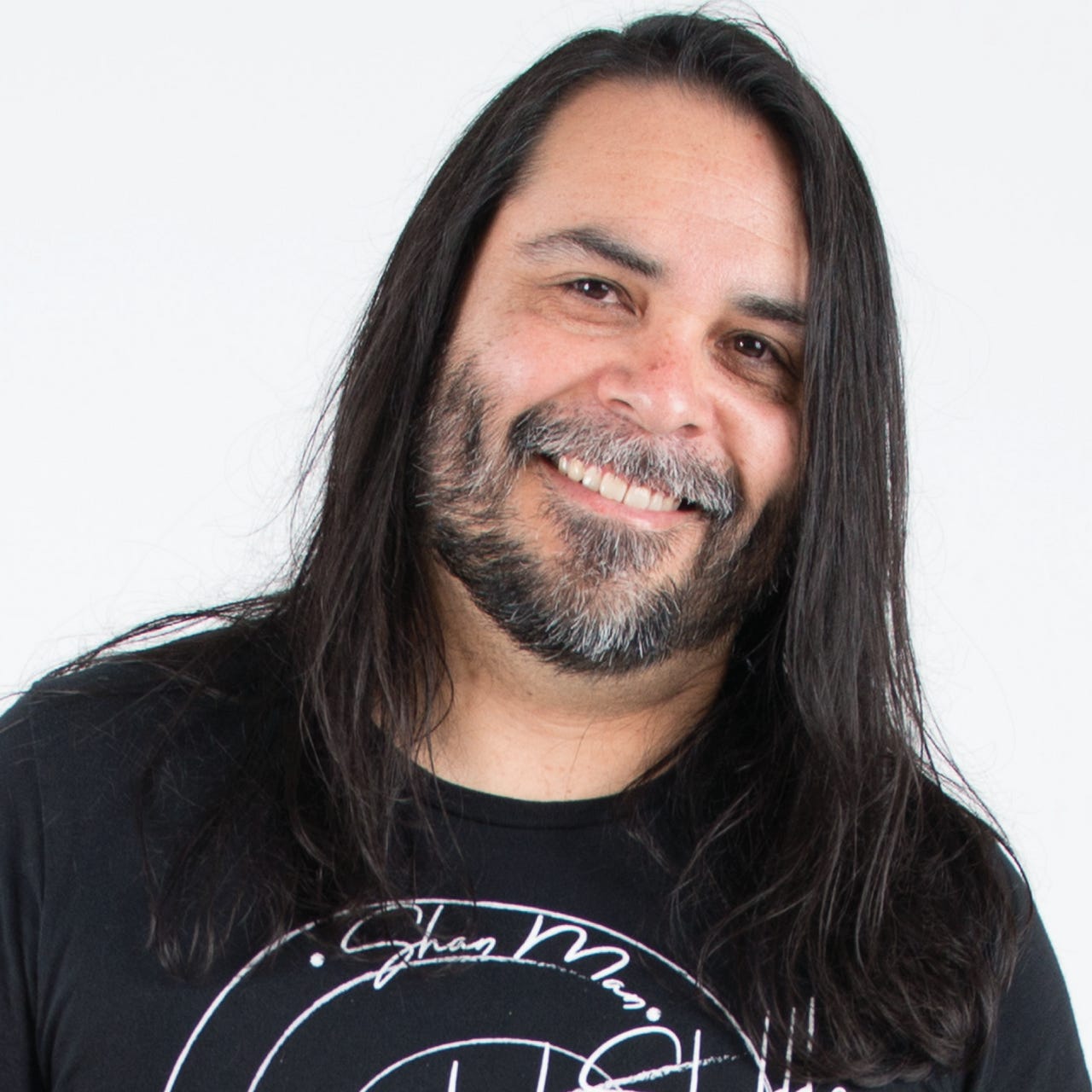The Big Red Easter Keg Hunt is 98 KUPD’s annual tradition of hiding 98 kegs across Phoenix—including one worth $5,000.
By sunrise, listeners are skipping work, deciphering barely legal clues, and tearing through industrial parks like it’s a city-sanctioned manhunt.
Cops stay on alert as reports roll in of suspicious digging, erratic U-turns, and four guys scaling a Walgreens dumpster like it’s Everest.
It’s part radio promo, part urban survival test—and for one glorious morning, it completely consumes the Valley.
This week marks the kickoff of one of my radio station’s most chaotic and cherished traditions: The Big Red Easter Keg Hunt.
The premise is simple: find a keg, turn it in, and you could win $5,000. But the prize is honestly just the glittery lure—because what people are really after is the street cred. It’s like getting inducted into a very dumb, very exclusive club that only exists between March and April and has zero actual perks—except for clout and maybe a weird sunburn. It’s the kind of thing that gets you nods of respect in certain bars. The kind of flex that doesn’t need explaining to anyone who’s ever tuned into Holmberg’s Morning Sickness and heard the words, “It’s on.”
If you’re new here, let me back up a little—because this isn’t just another cheesy radio stunt you hear in other cities. Our Easter Keg Hunt is the kind of thing that makes people set alarms, skip work, and tear apart industrial parks like they’re looking for buried treasure… because, in a way, they are.
In my 25 years with 98 KUPD, we’ve never been a station that phones it in when it comes to listener experiences. We’ve brought people backstage. We’ve hosted intimate patio performances with national acts like Alice in Chains and Zakk Wylde from Ozzy Osbourne. We’ve built festivals from the ground up.
When it comes to putting on a show, we go all in—as much as our budgets can handle.
But there’s something about the Easter Keg Hunt that taps into a very specific, very weird kind of vibe—both for us and for our listeners.
Every year, we, the staff members at the station, hide 98 actual metal beer kegs—yes, real full-sized, industrial-grade, party-stained, dented kegs—across the entire Phoenix metro area. Not toy kegs. Not decorative props. These are the kind of kegs that turn you into a chiropractor’s recurring revenue stream—and they’re empty.
It’s something I still haven’t fully figured out, especially when 21-year-olds—who weren’t even born when this thing started—talk about it with the kind of focus and emotional intensity usually reserved for religious pilgrimages or fantasy football drafts. They don’t just do it. It’s who they are now—because their parents were doing the same thing while they were strapped into a car seat, gnawing on Cheerios.
Here’s where it gets especially absurd—in the best way possible: all 98 kegs are hidden in the span of a few hours on Good Friday morning, before the morning show cracks the mic open at 6A.M.
Staff members (including yours truly) scatter across the city under cover of darkness, stashing these heavy-ass metal barrels behind dumpsters, in back alleys, under piles of landscaping debris, or in places that require an actual Jeep with 4-wheel drive to even approach. It’s the opposite of what geocaching was meant to be. Geocaching is about subtlety. The Big Red Easter Keg Hunt is about weaponizing just enough information to derail your entire Friday before 9 A.M.
And then the real fun starts: each of us provides a “clue” on where we left our keg. I say “clue” because the definition is largely loose in this circumstance. Some staffers will give you exact cross streets. Others get weirdly poetic, like, “Where the pavement cries and the pigeons watch,” and somehow listeners still triangulate it to a Waste Management dumpster on 35th Ave.
It all plays out live on the morning show during the height of drive time. So while everyone else is half-listening to traffic reports, our audience is blowing up our phones, deciphering riddles, and speeding off to some sketchy corner of Glendale—right about the time the cops start wondering why four trucks and a Subaru are doing donuts behind an industrial park. Listeners have literally abandoned their cars mid-parking maneuver just to comb through an open field of shrubbery because someone on the air said “by the bins near the Walmart.”
But I should probably confess something.
This isn’t just me guessing where to stash a keg and hoping for the best. I’ve trained for this. Long before the Easter Keg Hunt was something I had to “do for work,” I was out geocaching with my brother—back when geocaching required an actual GPS unit that looked like a rejected early prototype for a Nokia phone. This was before smartphone apps. Before Google Maps could think for you. You had to input coordinates one button-press at a time using a rubber keypad engineered to slowly euthanize your thumbs.
Once the coordinates were entered, we’d drive to some obscure parking lot, patch of desert, or hiking trail and start searching for a hidden container the size of a film canister—sometimes smaller. These things could be magnetized under a bench, tucked into a hollowed-out tree limb, or, in one of the most memorable hunts we ever did, disguised as a rock in a grocery store parking lot.
And I don’t mean vaguely rock-like. I mean someone had glued a plastic cache container into the base of an actual chunk of gravel, buried it upright in the dirt, and left the gravel side visible. It looked like every other rock around it. It took us an hour to find it. And when we did? I wasn’t even mad. I was inspired.
After that, my brother and I started creating our own caches designed to mess with people’s expectations—slightly unfair, but always findable. Which is probably why, when I got asked to hide kegs for KUPD, I didn’t hesitate. I already knew how to hide things in plain sight. I had spent years preparing for this moment, only now the containers were thirty pounds and smelled vaguely like stale beer and spray paint.
In those early days, the absurdity wasn’t just in the hunt—it was in how we made it happen.
Back then, The Big Red Easter Keg Hunt was introduced as a morning show promotion—which meant the morning show crew got to hide their own kegs and then deliver clues on-air with a straight face. But it quickly ballooned into a full station-wide operation. So when our promotions director, Mark Randall, called for volunteers to help hide the remaining kegs, Bret Vesely and I raised our hands so fast you’d think there was a cash prize for enthusiasm.
There wasn’t. But we were still trying to find our feet in radio—eager to prove ourselves, or at the very least, be useful. And with 98 kegs to hide, useful meant expendable.
On the night of the very first hunt, staff and sales reps gathered at the station like it was some kind of low-budget heist movie. Kegs were everywhere. Mark—who had the focused intensity of a retired Navy guy (because he was a retired Navy guy)—kept a clipboard and an evolving system to track where every keg was headed. It was duct tape, dry erase markers, and the blind faith that nobody would get arrested. But it got refined over time.
As for Bret and me, Mark gave us as many kegs as we could physically manage.
I loaded four into my 2003 Corolla—its suspension never forgave me. Bret borrowed his buddy’s pickup truck, and we filled it to the brim. I started by hiding mine in and around the Ahwatukee area. Then I’d circle back to the station, hop in the truck with Bret around 2:30 A.M., and we’d head back out into the night with a full keg payload and the jittery optimism of people who had absolutely no plan.
That was also the night I had my very first Red Bull. I regretted every vibrating, heart-palpitating second of it.
Because Bret and I had a habit of haunting bars in Tempe, Mark assigned us to that area. And because we were creative—and a little overconfident—we were determined to make our hiding spots good. But in that first year? “Good” was a sliding scale. I remember Bret wanting to hide one right in front of the Tempe Marketplace sign on McClintock. I told him that was basically leaving it in someone’s lap. He disagreed and gave the listeners less credit than they deserved. I said, “Okay, it’s fine by me.” I didn’t push too hard—Bret didn’t know I was a former geocaching nerd with strong feelings about how not to make things too easy.
Still, we played it pretty safe that first year. Until we got to the last keg.
A few weeks earlier, Bret and I had joked about hiding one on top of Tempe Butte—aka A Mountain, the giant letter A overlooking Arizona State University. When we floated the idea to the other staffers, they blew us off. But that night, we decided to do it. For real.
We saved it for last. It would require a hand cart. And lungs. And strength. None of which we had.
We were two out-of-shape radio jocks. I was still a pack-a-day smoker. Bret lived on beer and Italian sarcasm. This was not a great setup.
We parked the truck at the base of A Mountain and pulled the keg onto the hand cart. I turned to Bret and said, “You ready?” He said yes, but neither of us was.
Now, if you know anything about A Mountain, you know it’s not really a mountain. It’s a butte. But even paved buttes can feel like Everest when you’re hauling dead weight uphill at 2 A.M. in the dark with a borrowed hand cart and adrenaline-fueled caffeine shakes.
Other mountains around the Valley are rocky and treacherous—real ankle-breakers with bonus rattlesnakes. A Mountain is none of that. It’s steep, but paved. Manageable. Until you’re dragging a keg up it.
We barely made it 100 feet before we started gasping like chain-smoking asthmatics in a sauna. We took turns hauling the keg 25–50 feet at a time. It was like a scene from a buddy cop movie that went straight to DVD. Or better yet, that moment in Ghostbusters when they climb the stairs to fight Gozer and get winded halfway up. Except instead of advanced technology on our backs, it was me, Bret, a keg, and a plan that didn’t go beyond “let’s see how far we make it.”
The whole climb was brutal.
I lost count of how many times we traded off the hand cart, but what should’ve been a 15-minute hike took us almost 40—just to reach the lookout. Not the top of A Mountain. Just the paved part. The civilized part. The part where people take a selfie with the sunset in the background to convince themselves the view is a metaphor for personal growth—when really, it’s just elevation and decent lighting.
But we weren’t done.
See, the top of A Mountain—the actual “A” itself—was another story entirely. There was no path, no handrails, and certainly no courtesy incline. Just loose rock, patches of gravel, and what looked like ancient stone—barely held together by erosion, spray paint, and a decade’s worth of underwhelming ASU football. It wasn’t a trail. It was a dare. And we accepted it.
The goal was still to hide the keg on top of the A—the chef’s kiss of all hiding spots. The kind of placement that says: "Someone went too far... but in a good way."
We stared at the A, then at the sketchy path, then at each other—both of us silently hoping the other guy would be the first to break and say, “Fine, I’ll do it.” I don’t remember who spoke first. I just remember Bret—who’s eight inches taller than me and built like someone who doesn’t say no to a challenge—hoisting the keg onto his back like some post-apocalyptic UPS guy and starting the climb.
He fell a few times. Gasped a lot. Dragged it part of the way when it stopped being reasonable to lift. I sat near the bottom—watching, laughing, wheezing through leftover Red Bull, and trying not to feel guilty for not helping. Every time Bret slipped, there was a fresh grunt and a string of profanity, in true off-air Bret fashion.
But somehow, he made it.
He gave the keg one final yank and planted it on top of the A like he was raising a flag on behalf of everyone who ever said, “Yeah, I’ve got time tonight.” It was glorious. I had a photo of it—somewhere. Probably lost on an old hard drive or burned onto a CD that no laptop can read anymore.
I still remember what Bret said as he caught his breath and looked out over the lights of the city:
“Someone better fuckin’ appreciate this one.”
We sat for a minute, catching our breath, basking in the absurdity, then grabbed the hand cart and started our descent. That’s when we realized something important: our legs no longer worked. Every step down was a gamble. Trying to keep that hand cart from turning into a runaway missile was like playing tug-of-war with gravity while your thighs screamed for mercy.
Was it exhausting? Absolutely. Was it worth it? Well…
We made it back to the station just before Holmberg went live. I can’t remember if John saw us beforehand, but I do remember him comparing us to a buddy cop movie. That felt generous. We looked like two guys who had tried to prove something and mostly just proved we needed better cardio.
We stuck around for the first few clues when the show kicked off, but at some point, our bodies shut down and told us it was time to go. I still had a night shift to work, so I needed sleep. Luckily, I lived just across the freeway from the station in Guadalupe—a five-minute drive home, which was exactly as long as I could keep my eyes open.
I collapsed into bed, but curiosity wouldn’t let me rest. I turned on my clock radio and listened as the chaos unfolded live on-air. I was half-asleep by 7 A.M., drifting in and out of consciousness while people across the Valley tore up alleyways, parks, and dirt lots chasing clues.
That A Mountain keg? It was one of the last to be found.
The hint?
“It’s on A Mountain.”
Simple. Obvious—if you live here. But the way Holmberg said it on-air, it sounded like “a mountain,” as in any mountain.
People were like:
“Wait—what mountain? South Mountain? Camelback? Is this a trick? There aren’t any mountains in Tempe!”
They never thought to look at the A. The one staring them in the face every time they drove through Tempe. The one with a beer keg sitting on top like a prize from an alternate-reality video game.
It took all morning. People scoured the city like it was the end of a scavenger hunt and the fate of the world was at stake. And then finally, one lucky group figured it out, made the climb, and found the keg. They were like Indiana Jones—if the treasure was aluminum and smelled like a frat party.
And that?
That was the moment the Easter Keg Hunt went from being a fun radio bit to a full-on urban legend.
Because if someone was dumb enough—or ambitious enough—to hike a keg to the top of a mountain, then everything became fair game.
There was no way Bret and I were going to top that first year. Once listeners understood the rules, figured out the game, and knew that we wouldn’t hide near government buildings, churches, schools or nuclear plants the next Easter Keg Hunt became something else entirely—strategic, relentless, slightly stalker-ish. We had people parking outside the station in the middle of the night, hoping to intercept staffers and grab a keg before it even left the building.
To be fair, they weren’t threatening us. It was more like an emotionally manipulative hostage negotiation.
“I know you’ve got a keg, man. C’mon, I’ve got my kid in the car. Just hand it over.”
And to be even more fair... I probably didn’t help the situation.
By the second year, I’d fully committed to a bad habit of going on-air days early just to throw people off. Officially, the hunt didn’t start until Good Friday when the morning show went live. Unofficially, people were already scouring the city by Wednesday because I couldn’t help myself.
Listeners would call the request line:
“Hey, you said there’s a keg at 51st and Northern—I’m here, but I can’t find it.”
I had no idea what was even on that corner, but that didn’t stop me from weaponizing their enthusiasm.
“Did you check the culvert?”
“What culvert?”
“There’s a fountain nearby, right? Try right behind there.”
“There’s no fountain.”
“Well, maybe someone took it out or turned it off.”
I sent people on wild keg chases through apartment complexes and industrial lots they had no business walking through. It wasn’t just trolling—it was creative misdirection. A public service. I was keeping the chaos alive.
And it worked.
One year, I didn’t even hide a keg—but I did show up at a shopping center with two boxes of donuts, a couple cases of Dunkin’ coffee, and a plan that revolved entirely around misleading people in person. I stood there with them—sipping coffee, chatting, letting the mystery simmer—never confirming or denying if there was actually a keg involved.
My car stereo was blasting the station, so everyone could hear Holmberg announcing which kegs had been found. I even texted him to tell him where I was—just to see what he’d do. He went on the air, laughed, and flat-out told listeners that I was lying and they should move on.
But no one did.
They stood there, listening to the broadcast while being called out on the broadcast, refusing to leave. It was like they’d fully committed to the idea that I was bluffing about bluffing.
Some genuinely believed the keg was in the trunk. Others stuck around thinking I might casually drop the real clue at any moment—like I was just waiting for the right time.
At one point, I remember thinking I should’ve filmed the whole thing like a nature documentary—just pan slowly across the lot and whisper, “Here we see the adult Easter Keg hunter, fueled by caffeine and poor decision-making, waiting for something that absolutely isn’t coming.”
In the end, I handed out a couple of KUPD bandanas like it was the grand prize.
They didn’t riot.
They just stood there, a little confused, quietly unsure whether to be grateful or mad at me.
They took the bandanas anyway—because I think part of them didn’t want to admit they’d wasted three hours on free coffee and a lie.
But that’s the thing: the chaos is the plan.



One year, our station photographer Kenny became an accidental legend. Our digital department head, Dominic, pulled me aside and said:
“Let’s give out Kenny’s phone number and call it the Keg Hint Hotline.”
Now, under normal circumstances, I wouldn’t do something like that. And in this case, I didn’t. When Dom pitched the idea, I told him, “I’m not giving out Kenny’s number... but you can if you want to.”
And that’s all he needed to hear.
Next thing I know, Dom’s on the air giving out Kenny’s number—while Kenny is standing right there in the studio. The look on his face was a mix of betrayal, disbelief, and “this tracks.”
His phone lit up like a Christmas tree. For over an hour, it didn’t stop ringing.
At first, he tried to explain to listeners what had happened.
Then, somewhere around call #25, he just started giving out fake clues.
Eventually, he turned his phone off. And eventually he had to get a new phone number.
Meanwhile, outside the building, things were getting weirder.
That same night, Bret came in to work the overnight shift and noticed listeners camped outside the station—idling in their cars like they were staking out a celebrity rehab center or waiting for concert tickets that hadn’t been announced yet. I may or may not have encouraged this by hinting—on-air—that someone could probably get a keg just by showing up.
And someone did more than just show up.
They brought a drone.
Yes. A drone. Hovering like someone thought the keg hunt was being live-streamed on ESPN8, The Ocho, right after the cornhole semifinals. I don’t know what they expected to see. Did they think the drone would lock onto a keg behind the dumpster and flash “Objective Updated: Secure the Keg”—like they were trapped in a PS3-era copy of Modern Warfare 2, only the mission was set in a dimly lit radio station parking lot… and the only achievement unlocked was disappointment.
Bret, pretending to be disgusted in that way only Bret can, shook his head and said it: “Fuckin’ Shannon.”
With him, it always sounded like face-value disgust, but it was really more of a compliment—because he knew it would make a story someday.
And for the record, it’s always been “Fuckin’ Shannon” when it came from Bret.
Not because I’m dangerous—just the kind of guy whose fun ideas would make Dahmer tilt his head and say, “That’s a little weird.”
So here we are in 2025, doing another Easter Keg Hunt with pointless clues, locational stakes just as high as they were 20 years ago, sponsored kegs, and smarter chaos from the listeners.
These days, the keg hunt doesn’t feel like a rogue mission—it feels like logistics cosplay. We’ve got branded barrels, digital clue sheets, and listeners demanding real-time updates like they’re tracking an Amazon package. At least three people a year insist they parked right next to a keg… and somehow still didn’t find it.
The charm used to be in the scramble—the misdirection, the secrecy, the thrill of not knowing whether you were closing in on victory or just tearing apart a city-maintained mulch bed like it owed you money. And honestly, I miss that a little. The weird purity of it.
But if there’s one thing I’ve learned after all these years, it’s this:
Hiding kegs for this station is the only job where doing it too well guarantees someone will accuse you of ruining their life on Facebook.
And honestly?
That’s the kind of legacy I’m proud of.
Like what you just read? Do me a solid.
📬 Subscribe to the newsletter—free or paid. Sharing it with someone who loves a good laugh, a weird radio tale, or just a solid story goes further than you think.
Putting these together takes time. A lot of it. Digging through old hard drives, crumpled photos, and folders named things like “KegHunt2007_FINALfinal.pdf” just to piece it all back together.
If you decide to support this newsletter with a paid subscription—it doesn’t just help.
It amplifies everything.
And it means I can keep pulling these stories out of the dusty, beer-stained corners of radio history.
Thanks for reading. Seriously.
















Share this post